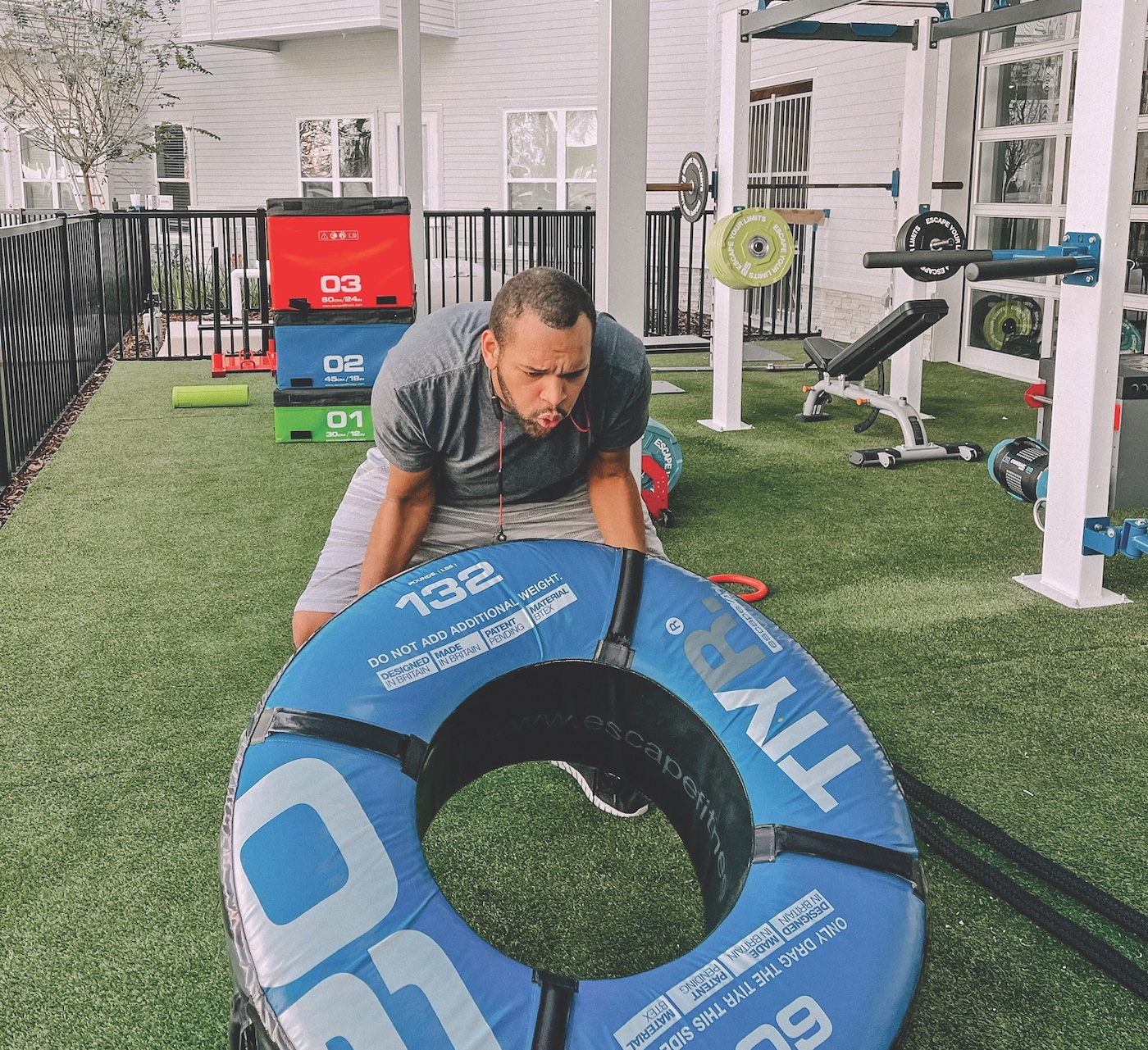The pandemic hit some building sectors, notably hospitality, extremely hard, while others—warehouses, cold storage, and life science facilities—have experienced an unexpected bump thanks to the pandemic.
Meanwhile, multifamily housing keeps rolling merrily along. The U.S. Census Bureau (“Construction Spending,” January 2021) estimated multifamily construction at $92.7 billion for 2021, up 16.9% year over year. That makes multifamily the second-largest commercial construction sector, after Education ($106.2 billion). As one multifamily developer put it (in response to our exclusive “Amenities Survey 2021”), “We have 1,250 units under construction and 2,000 on the boards.” What, me worry?
For our third Multifamily Amenities Survey, we asked multifamily developers, architects, contractors, and others in the sector how the pandemic had affected the amenities they provided for their rental, condominium, senior living, and student housing communities. Free download: Multifamily Amenities 2021 report
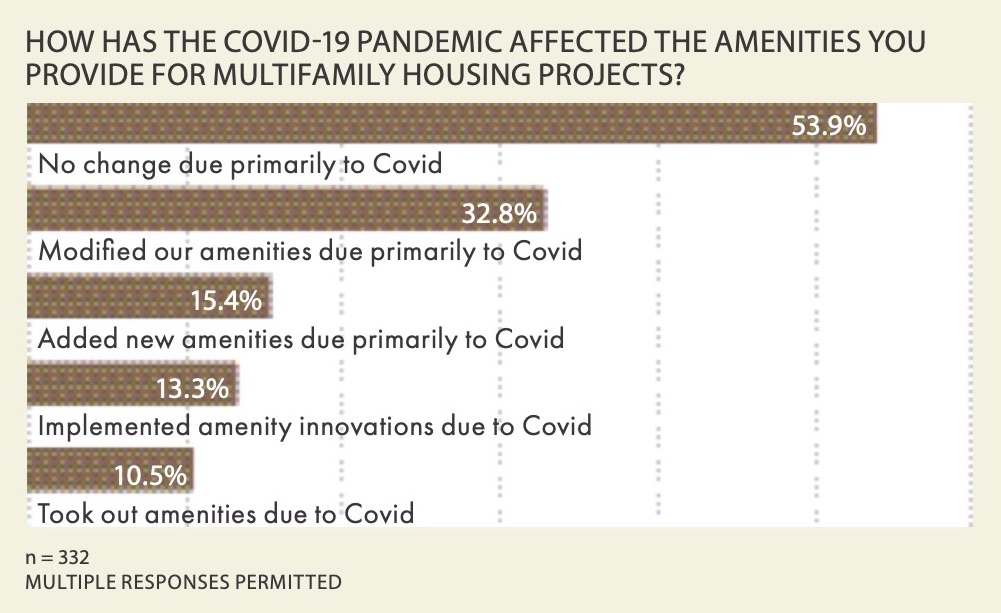 The majority of respondents to our “Amenities Survey 2021” said they had not changed their amenities due primarily to the pandemic, but others said they had modified, added, or removed amenities or introduced amenity innovations.
The majority of respondents to our “Amenities Survey 2021” said they had not changed their amenities due primarily to the pandemic, but others said they had modified, added, or removed amenities or introduced amenity innovations.
COVID’S EFFECT ON MULTIFAMILY AMENITIES: NOT SO MUCH
Perhaps the most surprising finding was that most respondents (53.9%) said they had made no changes to their amenities due to Covid. “We have not cut back the usual high-quality amenities,” said one respondent. Said another, “Our projects are anticipated to be completed in the future and clients believe Covid will be behind us.”
Others were too far down the construction path to make changes. “No change,” said Christopher L. Gartner, PE, CEO of Texas project management firm Gartner & Associates, “we’re thinking life goes back to a more normal condition soon.”
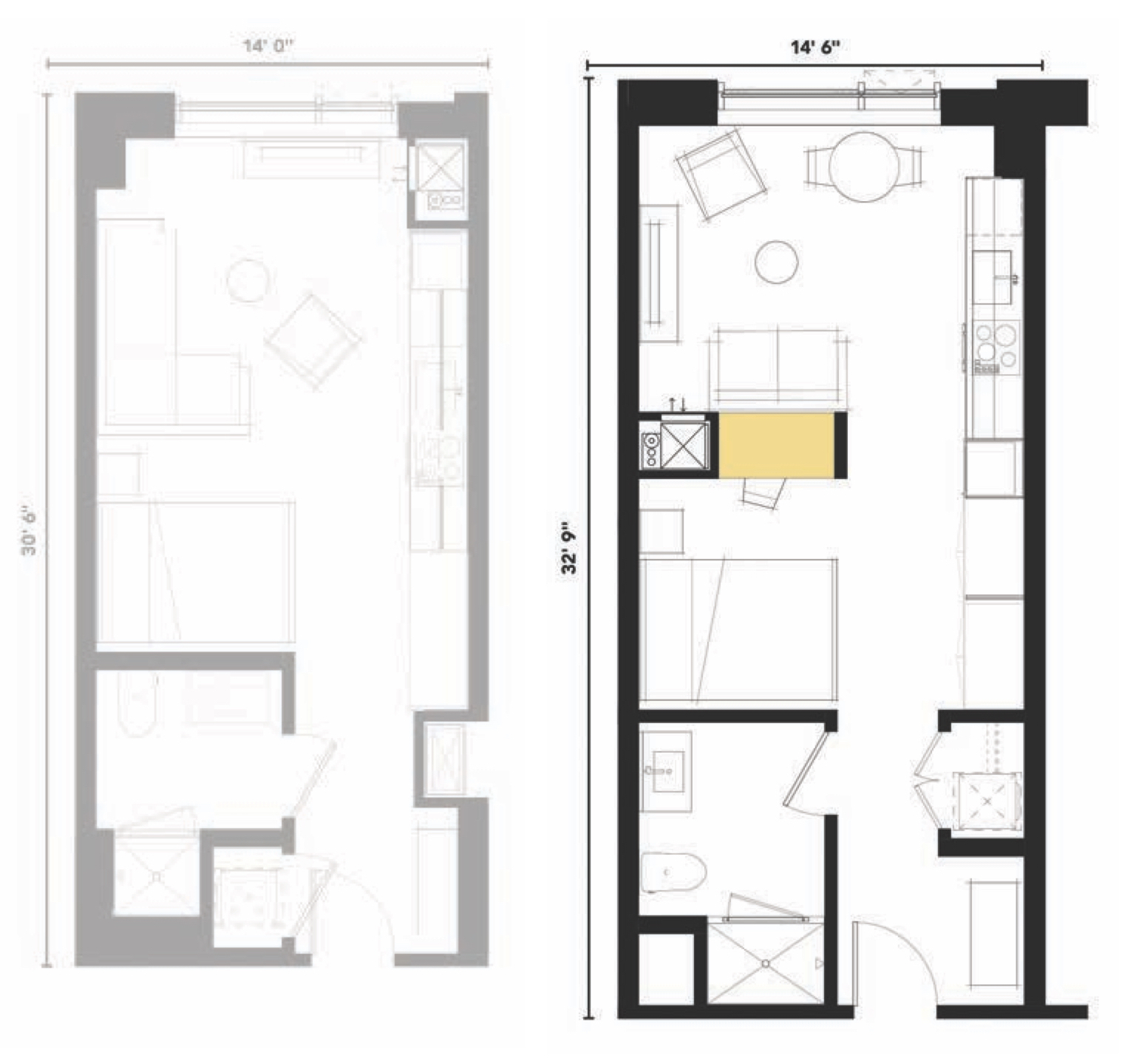 R. Vickie Alani, AIA, Principal at Boston-based CBT, has developed floor plans to create workspaces by adding a little footage to studio and one-bedroom apartments. Here, a 427-sf studio is lengthened six inches and widened two feet three inches, resulting in a 474-sf unit with a workspace. See: https://bit.ly/3h1dpao for more CBT floor plans.
R. Vickie Alani, AIA, Principal at Boston-based CBT, has developed floor plans to create workspaces by adding a little footage to studio and one-bedroom apartments. Here, a 427-sf studio is lengthened six inches and widened two feet three inches, resulting in a 474-sf unit with a workspace. See: https://bit.ly/3h1dpao for more CBT floor plans.
MAKING ‘MODIFICATIONS’ TO MULTIFAMILY AMENITIES
Some respondents (10.5%) said they had eliminated or mothballed amenities in light of CDC guidelines and state/local mandates. “We had to remove the free coffee bar,” said Cameron Anderson, Vice President of Construction, Westchase Construction Ltd., Houston.
Other responses: “Exercise rooms were closed, then reopened with limited access.” “Some of our retail closed entirely.” One respondent simply removed some furniture in common areas. Many respondents said they closed recreation amenities like dog parks, children’s playgrounds, volleyball courts, and game rooms, at least until their local social distancing guidelines loosened up.
At Hickory Hills East, Great Mills, Md., Raleigh Apt. Management removed all pool furniture, “but we allowed residents to bring their own chairs,” said a respondent. But “residents were very angry” when operators had to close fitness centers and swimming pools, said another respondent.
The second-largest group of respondents, nearly one-third (32.8%), said they had made efforts to “modify” amenities due to Covid, often through simple means: “Made dining areas larger so tables/chairs could be farther apart.” One reported benefiting from the pandemic: “Our workload has increased due to Covid. Clients are coming back to us to design Covid retrofits of existing buildings.”
WFH—’MORE SPACE, PLEASE’
Multifamily project teams had to scramble to accommodate the overwhelming demand for work-from-home spaces for adults and study spaces for children. Neil Liebman, AIA, LEED AP, Managing Principal, said his firm, Bernardon, had “allocated space for a desk in all units, either in the bedroom or living spaces.” Jeff Mulcrone, AIA, Associate | Design Director in the Chicago office of BSB Design, said his firm is looking at adding 35-50 sf per unit to create WFH nooks.
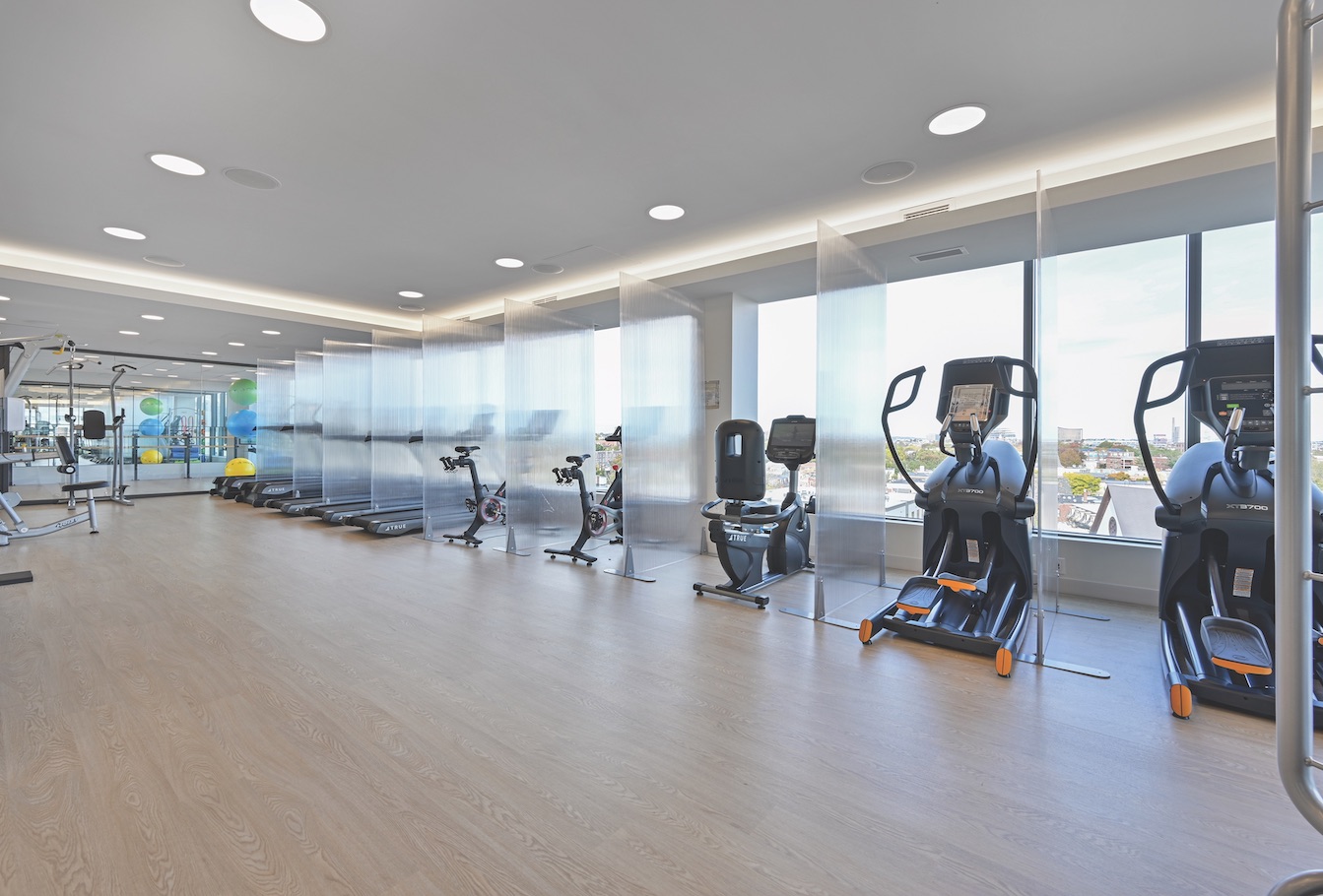 At Market Central, Boston, architecture firm CBT specified plexiglass separators to be placed between pieces of fitness equipment in response to Covid conditions. The plexiglass units were set on pads so that they could be moved easily. Twining Properties was the developer. Photo: @Flauntboston
At Market Central, Boston, architecture firm CBT specified plexiglass separators to be placed between pieces of fitness equipment in response to Covid conditions. The plexiglass units were set on pads so that they could be moved easily. Twining Properties was the developer. Photo: @Flauntboston
In addition to “larger units,” other WFH actions respondents had taken or were considering included:
• “In-unit work nooks”
• “Isolation suites”
• “Private phone booths” in business centers
• Greater emphasis on sound transmission between units
• “Need for solid Internet speed and bandwidth”
• “Varied environments,” based on cues from coworking spaces
Coworking spaces were a hot topic among respondents, one of whom stated, “In one project, we converted an entire floor to coworking space.”
PACKAGE CENTERS—THE FOOD/CARDBOARD EXPLOSION
The pandemic tested the limits of multifamily package centers, not only the “overwhelming volume and frequent theft” cited by one respondent, but also the immense piles of cardboard waste from all those delivery boxes. Respondents also reported adding grocery lockers and cold storage units to their package centers to handle the flood of bulk food and meal deliveries.
BREATHE DEEP: HEALTH AND WELLNESS WORRIES
Many respondents heeded the call for more stringent health and wellness measures to counter the virus. “Touchless controls/access,” “touchless doors and elevators,” “sensor-driven technology” were all cited. As one of them said, “We’re rethinking and reimagining our amenities packages to be safer, healthier.”
Among the health/wellness options cited by respondents:
• Antibacterial countertop surfaces
• Ultraviolet lamps to destroy microbes
• Touchless faucets in kitchens and bathrooms
• Hand-sanitizing stations in common areas
• Sliding doors at the entry to the leasing office
• Easily cleanable furniture
Stephanie Kirkpatrick, IIDA, ASID, LEED AP, Principal, Director of Interior Design, Niles Bolton Associates, told Horizon TV’s “The Weekly” (https://bit.ly/3vFIEf2) that “there may even be a movement to vinyl” due to that material’s cleanability.
One developer of affordable rentals closed all their common laundry facilities and installed washer/dryer combos in individual apartments as a health and wellness measure. “We have also considered one bath per bedroom to help with the quarantine,” said this responder.
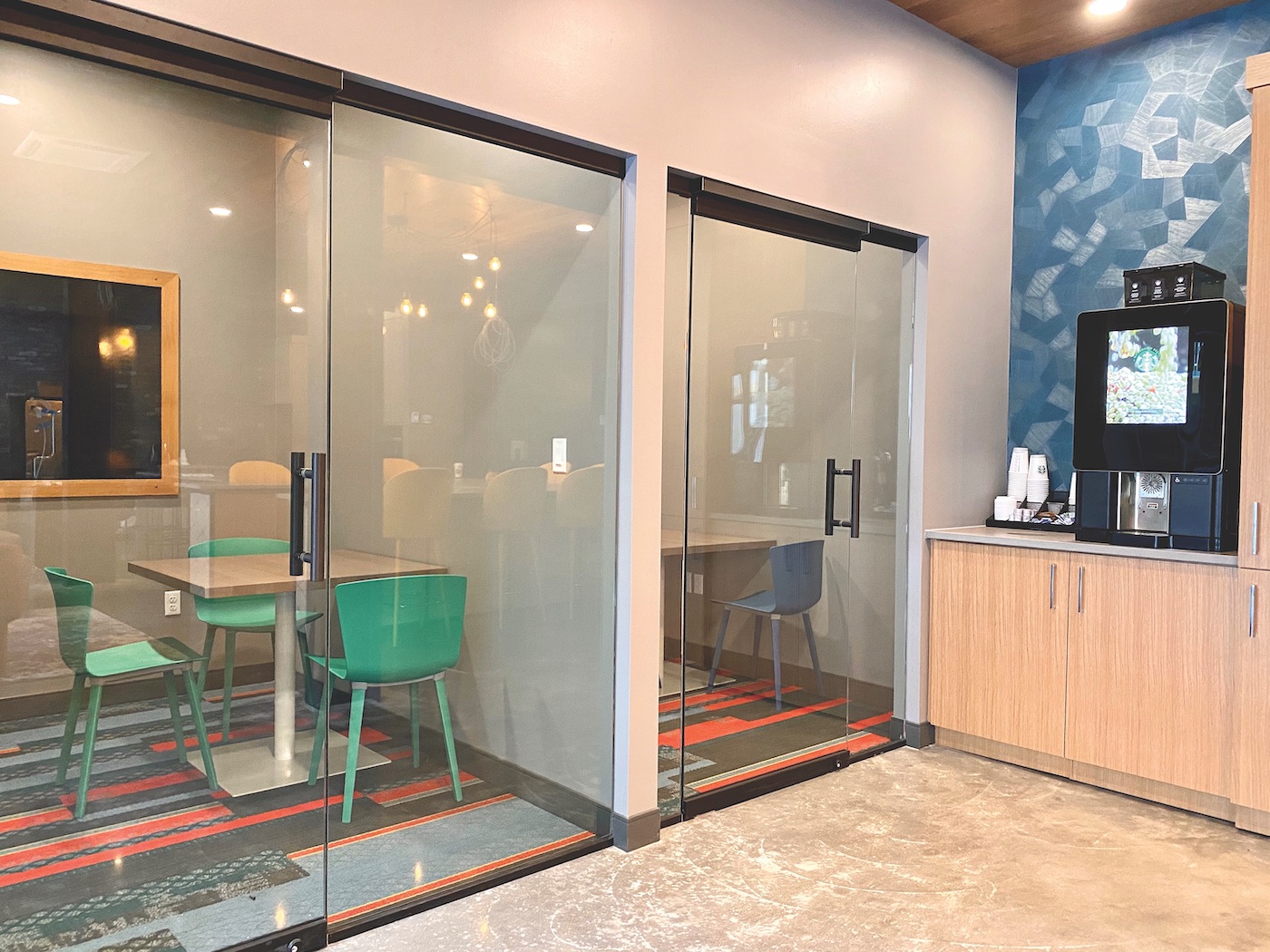 VE Design Group and Blair Kweskin Design, the interior designers on Hue, St. Louis, incorporated private offices into the business center. Covid-related “isolation pods” like this were mentioned by several Amenities Survey 2021 respondents. Green Street St. Louis was the developer on the 111-apartment complex. Photo: Square One - www.squareonepros.com
VE Design Group and Blair Kweskin Design, the interior designers on Hue, St. Louis, incorporated private offices into the business center. Covid-related “isolation pods” like this were mentioned by several Amenities Survey 2021 respondents. Green Street St. Louis was the developer on the 111-apartment complex. Photo: Square One - www.squareonepros.com
Healthier indoor air quality was a big item for respondents, who cited “HVAC upgrades,” “improved HVAC systems/filtration,” and “larger air purification systems.” One respondent was adding “commissioning of HVAC services” for existing projects. Another noted: “Installing air-purification systems at retrofit, in amenity spaces and elevators.” One predicted, “We will be adding air-purification systems to our amenity areas in future developments.”
GREATER ACCESS TO THE GREAT OUTDOORS
Access to nature and the outdoors captured the imagination of respondents. One pledged to “add more outdoor amenities to allow for social distancing.” Another said, “We’ve been asked to double/triple exterior areas” in upcoming projects. One respondent’s strategy was to “disperse amenities throughout the project rather than in one mega-amenity.” Yet another cited “proximity to parks” as a factor in future project location decisions.
Balconies gained attention as a means to reduce stress and the sense of isolation brought on by the pandemic. One respondent was able to capitalize on this in a project that was still in Design Development: “We added exterior balconies to every apartment.”
‘COVID EFFECT’: HOW LONG WILL IT LAST?
The long-term effect of the pandemic on multifamily amenities is hard to calculate. Can developers really afford larger unit sizes to squeeze in work-from-home nooks? Will multifamily design teams “incorporate better distancing into future projects,” as another suggested? Or will the multifamily sector revert to business as usual as soon as face masks are no longer mandatory?
Still, the long-term psychological impact of the worldwide pandemic cannot be underestimated. Even as many multifamily teams strive to create more of a sense of “community” in their projects, the pandemic “has taken the personality and companionship and human interaction out of play,” according to one respondent.
Will the multifamily sector—and society at large—find the means to overcome that malaise?
Related Stories
| Mar 22, 2011
Mayor Bloomberg unveils plans for New York City’s largest new affordable housing complex since the ’70s
Plans for Hunter’s Point South, the largest new affordable housing complex to be built in New York City since the 1970s, include new residences for 5,000 families, with more than 900 in this first phase. A development team consisting of Phipps Houses, Related Companies, and Monadnock Construction has been selected to build the residential portion of the first phase of the Queens waterfront complex, which includes two mixed-use buildings comprising more than 900 housing units and roughly 20,000 square feet of new retail space.
| Mar 17, 2011
Perkins Eastman launches The Green House prototype design package
Design and architecture firm Perkins Eastman is pleased to join The Green House project and NCB Capital Impact in announcing the launch of The Green House Prototype Design Package. The Prototype will help providers develop small home senior living communities with greater efficiency and cost savings—all to the standards of care developed by The Green House project.
| Mar 11, 2011
Renovation energizes retirement community in Massachusetts
The 12-year-old Edgewood Retirement Community in Andover, Mass., underwent a major 40,000-sf expansion and renovation that added 60 patient care beds in the long-term care unit, a new 17,000-sf, 40-bed cognitive impairment unit, and an 80-seat informal dining bistro.
| Mar 11, 2011
Mixed-income retirement community in Maryland based on holistic care
The Green House Residences at Stadium Place in Waverly, Md., is a five-story, 40,600-sf, mixed-income retirement community based on a holistic continuum of care concept developed by Dr. Bill Thomas. Each of the four residential floors houses a self-contained home for 12 residents that includes 12 bedrooms/baths organized around a common living/social area called the “hearth,” which includes a kitchen, living room with fireplace, and dining area.
| Mar 11, 2011
Texas A&M mixed-use community will focus on green living
HOK, Realty Appreciation, and Texas A&M University are working on the Urban Living Laboratory, a 1.2-million-sf mixed-use project owned by the university. The five-phase, live-work-play project will include offices, retail, multifamily apartments, and two hotels.
| Mar 1, 2011
How to make rentals more attractive as the American dream evolves, adapts
Roger K. Lewis, architect and professor emeritus of architecture at the University of Maryland, writes in the Washington Post about the rising market demand for rental housing and how Building Teams can make these properties a desirable choice for consumer, not just an economically prudent and necessary one.
| Feb 15, 2011
New Orleans' rebuilt public housing architecture gets mixed reviews
The architecture of New Orleans’ new public housing is awash with optimism about how urban-design will improve residents' lives—but the changes are based on the idealism of an earlier era that’s being erased and revised.
| Feb 11, 2011
Chicago high-rise mixes condos with classrooms for Art Institute students
The Legacy at Millennium Park is a 72-story, mixed-use complex that rises high above Chicago’s Michigan Avenue. The glass tower, designed by Solomon Cordwell Buenz, is mostly residential, but also includes 41,000 sf of classroom space for the School of the Art Institute of Chicago and another 7,400 sf of retail space. The building’s 355 one-, two-, three-, and four-bedroom condominiums range from 875 sf to 9,300 sf, and there are seven levels of parking. Sky patios on the 15th, 42nd, and 60th floors give owners outdoor access and views of Lake Michigan.
| Feb 11, 2011
Sustainable community center to serve Angelinos in need
Harbor Interfaith Services, a nonprofit serving the homeless and working poor in the Harbor Area and South Bay communities of Los Angeles, engaged Withee Malcolm Architects to design a new 15,000-sf family resource center. The architects, who are working pro bono for the initial phase, created a family-centered design that consolidates all programs into a single building. The new three-story space will house a resource center, food pantry, nursery and pre-school, and administrative offices, plus indoor and outdoor play spaces and underground parking. The building’s scale and setbacks will help it blend with its residential neighbors, while its low-flow fixtures, low-VOC and recycled materials, and energy-efficient mechanical equipment and appliances will help it earn LEED certification.
| Feb 11, 2011
Apartment complex caters to University of Minnesota students
Twin Cities firm Elness Swenson Graham Architects designed the new Stadium Village Flats, in the University of Minnesota’s East Bank Campus, with students in mind. The $30 million, six-story residential/retail complex will include 120 furnished apartments with fitness rooms and lounges on each floor. More than 5,000 sf of first-floor retail space and two levels of below-ground parking will complete the complex. Opus AE Group Inc., based in Minneapolis, will provide structural engineering services.


